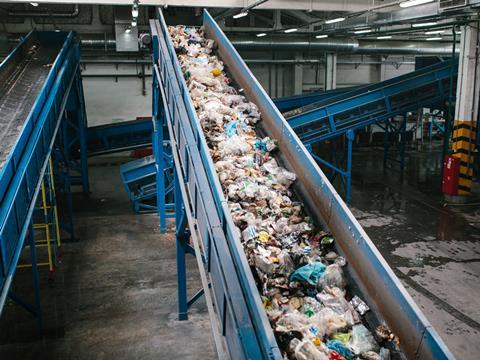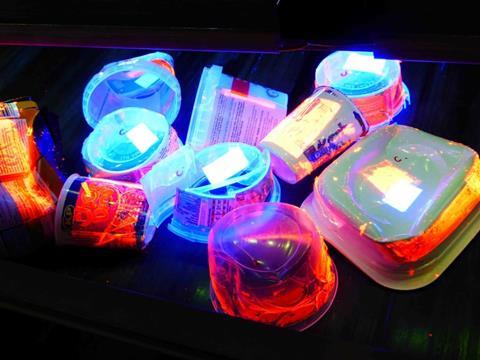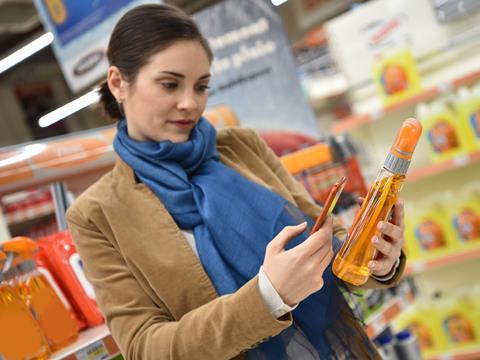
As Smurfit Kappa’s Arco Berkenbosch has observed, a key to the success of paper recycling is the fact that everything from corrugated board to newspapers can go into the same stream. Simplicity for the consumer is crucial to a high collection rate. Given the multiplicity of polymers used in packaging, raising recycling rates based on a single collection stream depends on solving the challenge of efficiently identifying and sorting different plastics. Having explored a number of approaches to this challenge, a number of value chain stakeholders are now investing in research around two technologies that could make an important contribution: tracers and digital watermarking. Tim Sykes reports.
As one of the biggest players in FMCG, and with a brand portfolio heavily reliant on plastic packaging, Procter & Gamble is actively engaged in the task of driving up recycling of the 15 million tonnes of plastic packaging waste the EU produces annually – only 30 per cent of which is currently recycled. At the Sustainable Packaging Summit at Gothenburg’s Scanpack on 23 October P&G’s principal scientist – packaging R&D, Gian De Belder, will introduce the pioneering ‘Holy Grail’ project, which is developing an industry-wide programme for tracer and watermark technology.

“To give innovative recycling technologies a chance, it’s crucial to establish international standards,” Gian De Belder suggests. “Both tracers and digital watermarks have the potential to simplify the sorting of packaging waste. Although it’s a positive that the EU Commission has recognised these technologies and encourages R&D, we currently lack a shared vision or common standards. That’s why we have instigated Holy Grail.”
How do they work?
Tracer-based sorting uses fluorescent pigments incorporated into the plastic substrate. These are only visible UV light at the sorting plant. Meanwhile, digital watermarks are codes that are integrated into design of the packaging, and detected by cameras on high-speed sorting lines. An additional nuance of watermarks is that consumers can ‘read’ them with their smartphones to check recycling information.
Oliver Lambertz, business development manager Segments at TOMRA Sorting GmbH – one of the partners in the Holy Grail project, elaborates. “Tracer systems based on UV fluorescence have UV markers are integrated either directly in the material matrix or in sleeves,” he tells Packaging Europe. “Sorting technology can then identify the fluorescence and separate marked objects from non-marked objects.”

Within digital watermarking a number of different systems are possible. “Watermarks can be printed, for instance on in-mould-labels or on sleeves, or they can be integrated in 2D or 3D moulds,” Mr Lambertz explains. “A watermark can carry a lot of information about the product and its packaging and could help to sort the materials based on defined specifications.”
Three-dimensional watermarking technology for plastics such as PET-bottles and trays, such as that developed by the Dutch company FiliGrade, provide waste sorters a unique method for selection. Nearly invisible to the human eye, the code can be read by a camera, in infrared, daylight or ultraviolet conditions. Covering the full product, the watermark’s readability is not affected by dirt, distortion or orientation. In addition, there is no chemical residue and therefore no impurities entering the recyclate.
However, it might be the potential of watermarking to double as a medium for consumer interaction that proves crucial supplying the added value that persuades stakeholders to make the investments required for widespread adoption. Consider for a moment the possibilities introduced by smartphone readability – from nutritional information and provenance details to marketing communication.

With big stakeholders such as P&G and TOMRA already showing interest, and converters such as Multivac already producing prototypes, it seems the value chain has taken note of this point.
Projects and potential
If these technologies can be made to work efficiently under industrial conditions in waste sorting installations, they can help distinguish materials that today are difficult to separate.
“The main focus currently is on materials which are difficult to sort and recycle today, such as carbon black coloured plastics, food vs non-food packaging or fully sleeved bottles,” Mr Lambertz says. There are still a number of innovation challenges between where we stand today and widespread implementation. “The variety of systems within digital watermarks and tracers requires different technologies for detection and sorting, of which some are more challenging than others. Development work is for some of these technologies still in an early stage. There is still a lot of work to be done, also on the detection and sorting side.”
As with every endeavour at innovation in the recycling infrastructure, alignment across the value chain will be essential to meet these challenges. “For well working circular systems the involvement of all stakeholders along the value chain is needed, starting from material suppliers, converters, brand owners, retailers, consumers to waste management and recycling companies,” Mr Lambertz comments. “It is very positive that this dialogue between stakeholders has significantly increased in the last years, also thanks to systemic initiatives like for instance the Ellen MacArthur Foundation’s New Plastic Economy. Implementing such new technologies requires a wide acceptance of different stakeholders, a certain standardisation and a feasible business model along the whole value chain.”

The Holy Grail project is one such collaborative effort, focusing on solutions for improved sorting efficiencies and setting standards for tracer and watermark solutions. As part of the initiative TOMRA is helping assess the technical feasibility of new sorting technologies. TOMRA has also been involved in the PRISM project, along with partners including Nextek, Brunel University, CCL, Mirage Inks, Cleantech Europe and WRAP. PRISM has developed coded labels using non-rare earth based luminescent compounds as well as materials recovered from fluorescent lamp recycling. In addition to assisting recovery of PP food packaging, HDPE milk bottles and sleeved PET, it is envisaged that the technology will open up new markets for recovered fluorescent compounds.
So are tracers and/or watermarking likely to transform the recycling landscape? It’s a bit early to make bold predictions.
“It’s still difficult to assess their impact on the recycling landscape, as it will largely depend on a wide acceptance both by packaging producers, brand owners, retailers and the possible business model for the waste and recycling industry,” says Mr Lambertz. “Any technology that can help to increase and improve recycling should be assessed. However, solutions for very fragmented streams are usually difficult to establish in the recycling industry. A certain volume is needed to make it economically feasible.”
Nevertheless, there’s broad consensus around the fact that ineffective separation is one of the fundamental reasons that so much plastic in Europe ends up in landfill or incineration. Mr Lambertz concludes: “Recovering these lost commodities would make a huge contribution to increasing recycling rates. Meeting future recycling targets requires holistic action and improvement, including design for recycling and increased collection rates – but improved sorting technologies will play a critical part.”
Come along to hear Gian De Belder discuss the Holy Grail project and P&G's broader sustainability strategies at the Sustainable Packaging Summit from 13:00 on 23 October at Scanpack, Gothenburg. Tickets to the Summit and Sustainability Awards 2018 are free but arrive promptly to ensure you get a seat.
















